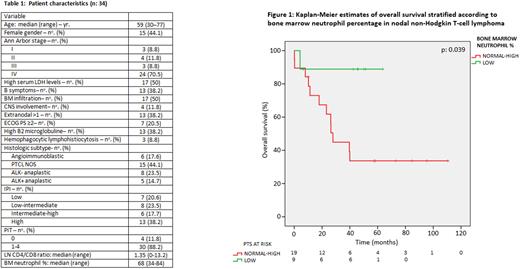Abstract
INTRODUCTION
Outcomes in nodal peripheral T-cell lymphomas (PTCL) remain poor. Baseline clinical risk indexes have shown to be prognostic but do not imply a change in therapeutic strategies. Many publications have addressed the role of tumor microenvironment (TME) in lymphomagenesis and disease progression. Particularly in PTCL, TME was shown to be profoundly immunosuppressive. Therefore, TME variables that may aid to improve risk stratification and treatment management are urgently needed.
AIMS
To determine the prognostic impact on survival in PTCL of:
-Conventional clinical risk parameters.
-The percentage (%) of immune cells (IC) in the bone marrow (BM) and lymph node (LN) measured by flow cytometry (FC).
METHODS
We retrospectively collected information of patients (pts) with PTCL and available BM aspiration and/or LN FC data at diagnosis, treated at our center between 2012-2021. FC analysis was performed with 8-color panels according to Euroflow protocols. % of BM and LN IC by FC were compared to normal values determined by Matarraz et al. (Cytometry part B 2010) and Battaglia et al. (Immunology 2003), and analyzed in 3 categories: low, normal and high. Survival analysis was performed with Kaplan-Meier (variables compared with log-rank) and multivariate analysis with Cox regression.
RESULTS
We included 34 pts, with a median age of 59 years. LN and BM FC data were available in 26 and 28 pts, respectively. Table 1 shows baseline patient characteristics. 85.4% received induction with CHOP or CHOP-like regimens (with etoposide or brentuximab). Complete remission (CR) rate: 52.9%. 14 pts received treatment with new drugs (brentuximab, belinostat, romidepsin or lenalidomide) in the relapsed/refractory setting. Only 10/34 pts underwent consolidation with autologous stem cell transplant (ASCT). Chemorefractory disease was the reason to forgo ASCT in 50% (12/24) of the non- transplanted pts and 3/12 underwent consolidation with allogeneic stem cell transplant in 1st CR. Median progression-free (PFS) and overall survival (OS) for the whole cohort were 15 and 72 months (m) respectively, with a median follow up time of 41.2 m.
Pts with ALK+ anaplastic T-cell lymphoma had improved PFS (median of 67 vs 8, 9 and 5.6 m for ALK- anaplastic, PTCL NOS and angioimmunoblastic lymphoma, respectively). Regarding prognostic indexes, PIT score was able to discriminate subgroups with different PFS (median of 15.3 m for pts with at least 1 risk factor vs not reached and PFS rate of 100% in those without, p: 0.012). Other clinical parameters such as BM and CNS compromise were associated with inferior PFS (median of 49.7 in BM not involved vs 6.7 m, p: 0.006; and median of 19.2 in pts without CNS compromise vs 3.45 m, p<0.001, respectively). The only TME variable with prognostic impact on PFS was LN CD4/CD8 ratio (median of 30.8, 5.7 and 2.7 m for the low, normal and high subgroups, respectively, p: 0.045). On multivariate analysis, absence of CNS involvement was the only independent predictor of PFS (HR: 0.009, CI95%: 0-0.235, p: 0.005).
The only clinical parameter with prognostic impact on OS was performance status (PS) (median of 72.2 vs 0.2 m in pts with PS≤2 and ≥3, respectively). Regarding TME variables, low BM neutrophil % was associated with improved OS with median not reached vs 27.8 m in pts with normal and high values, p: 0.039). BM neutrophil % did not statistically differ in involved vs not involved BM. Interestingly, only 1/9 pts with normal-high BM neutrophil % with relapse disease could achieve CR with 2nd line treatment vs 6/10 in the low % subgroup (likelihood ratio 5.26, p: 0.022). In contrast, no association was found between peripheral blood neutrophil counts and survival in our cohort. On multivariate analysis, only low BM neutrophil % remained as an independent predictor of OS with a HR of 0.12 (CI95%: 0.015-0.96), p: 0.046.
CONCLUSIONS Both clinical risk factors and TME variables showed prognostic impact in our cohort of PTCL pts. A high LN CD4/CD8 ratio and a normal-high BM neutrophil % were associated with decreased PFS and OS, respectively. These TME variables are widely accessible and could help refine prediction of prognosis in pts with nodal PTCL. Manipulating TME with therapeutic strategies that promote effector T-cell function and/or suppress the pro-malignant cell effects of myeloid derived cells may improve patient outcomes in this poor risk disease.
Disclosures
No relevant conflicts of interest to declare.
Author notes
Asterisk with author names denotes non-ASH members.


This feature is available to Subscribers Only
Sign In or Create an Account Close Modal